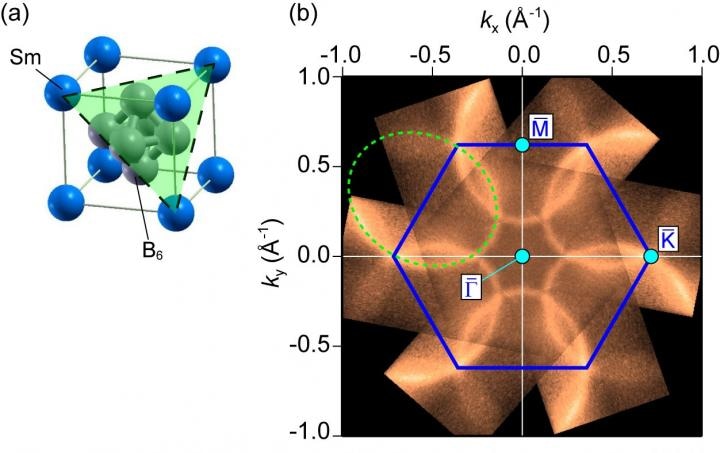Jun 11 2019
A group of researchers headed by Osaka University employed angle-resolved photoelectron spectroscopy to explore the peculiar surface conductivity of samarium hexaboride crystals.
 (a) Crystal structure of SmB6. A shaded area is the (111) surface studied in the current work. (b) Surface electronic structure of SmB6 obtained by angle-resolved photoelectron spectroscopy. Bright area represents the electrons with corresponding wavenumber (Fermi surface). A solid hexagon is the zone boundary determined from surface periodicity. (Image credit: Osaka University)
(a) Crystal structure of SmB6. A shaded area is the (111) surface studied in the current work. (b) Surface electronic structure of SmB6 obtained by angle-resolved photoelectron spectroscopy. Bright area represents the electrons with corresponding wavenumber (Fermi surface). A solid hexagon is the zone boundary determined from surface periodicity. (Image credit: Osaka University)
They demonstrated that the material is a co-existing phase of “topological insulator” where electrical current can pass along the surface but not through the bulk of the sample, a “Kondo insulator,” which experiences a metal-to-insulator transition because of the strong electron correlation.
This research—which shows that topological insulators can simultaneously have strong electron correlations—might enable the advance of quantum spin devices that employ the magnetic spins of individual electrons to perform better than existing computers.
A long-standing debate has existed regarding the metallic surface electronic structure of samarium hexaboride (SmB6). SmB6 is identified to be an insulator only at low temperatures because of strong electron correlations, known as the “Kondo effect.” Kondo insulators are different from most materials in that their resistance actually increases with reduction in temperature. However, the source of the remnant conductivity at low temperatures is yet to be discovered.
An accepted hypothesis is that SmB6 is also a topological insulator, which can have metallic electronic phases on its surface. However, the surface electronic structures of SmB6 achieved to date have been intricate and difficult to understand and thus this question of whether SmB6 is certainly topological or not has been a never-ending debate. In this research, the group examined the surface states from a new crystal orientation and succeeded in considerably simplifying the surface states.
The key insight was measuring along a specific surface direction, which had earlier been hard to perform. In order to achieve this surface, the scientists had to first prepare an atomically flat, very clean surface of the crystal in an extremely accurate manner. They executed this by heating a single crystal of samarium hexaboride to extremely high temperatures in an ultra-high vacuum chamber.
They subsequently carried out angle-resolved photoelectron spectroscopy, which observes the electrons expelled from the crystal upon exposure to powerful beams of light. In addition to determining the speeds of the electrons, they also determined if their spins were oriented up or down using a ferromagnetic detector.
We were able to show that samarium hexaboride is a topological insulator, without any ambiguity. This opens a new research area in which strong correlations and topological effects can exist in the same material.
Shin-ichi Kimura, Study Lead Author, Osaka University